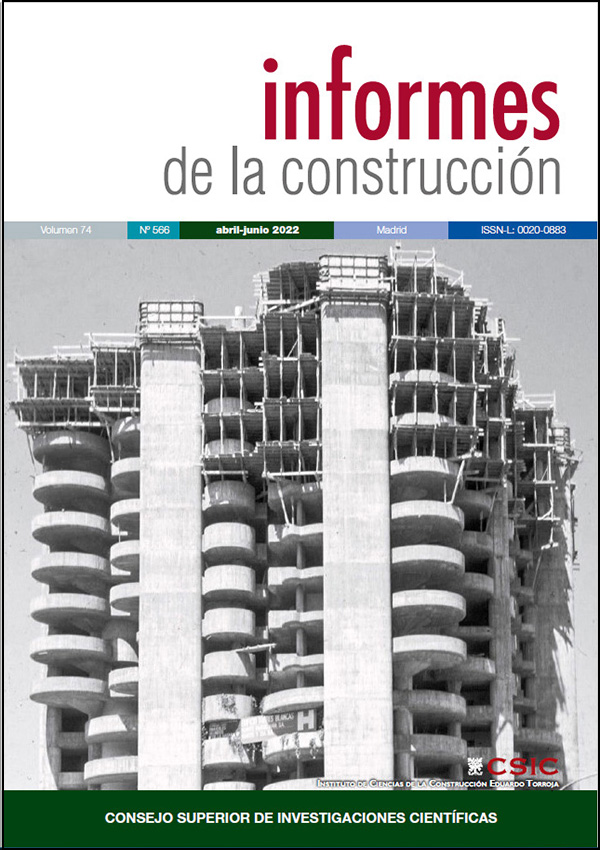Desarrollo de modelos estadísticos para la predicción de propiedades mecánicas del hormigón simple
DOI:
https://doi.org/10.3989/ic.83314Palabras clave:
resistencia a la compresión, propiedades mecánicas, hormigónResumen
La resistencia a la compresión del hormigón se considera una propiedad índice del hormigón y, por lo tanto, otras propiedades mecánicas del hormigón, como la resistencia a la flexión y el módulo de elasticidad, están correlacionadas con ella. Las prácticas del código estándar de diferentes países proporcionan correlaciones empíricas entre la resistencia a la compresión y las propiedades mecánicas. Sin embargo, se observa que estas correlaciones arrojan resultados desviados. El presente artículo tiene como objetivo desarrollar modelos estadísticos para estimar con precisión estas propiedades en base a resultados experimentales. Las muestras de cubos, cilindros y vigas de concreto simple se moldean con una relación agua-cemento y una relación agregado-cemento variables. Con base en los resultados experimentales, se desarrollan los modelos de predicción de la resistencia a la compresión, la resistencia a la flexión y el módulo de elasticidad. Los resultados experimentales se comparan con los resultados obtenidos a partir de modelos estadísticos generados, así como con los resultados disponibles de la literatura. Se encuentra que los modelos actuales predicen con precisión las propiedades mecánicas de los hormigones.
Descargas
Citas
(1) BIS, IS. (2000). 456 (2000). Plain and reinforced concrete Code of Practice. Bureau of Indian Standards, New Delhi, India.
(2) ACI Committee (1999). Building code requirements for structural concrete: (ACI 318-99), and commentary (ACI 318R99). American Concrete Institute.
(3) Milburn, J.R., Park, R. (1982). Behavior of Reinforced Concrete Beam Column Joints Designed to NZS 3101. Department of Civil Engineering, University of Canterbury.
(4) Walraven, J.C. (2008). Eurocode 2: Design of Concrete Structures EN199211 [C]. In Symposium Euro Codes: Background and Applications, Brussels.
(5) Standard, B. (1985). 8110: Part 1, Structural use of concrete-code of practice for design and construction. British Standards Institute, London UK, 38.
(6) Canadian Standards Association. (2004). Design of concrete structures. Mississauga. Ont.: Canadian Standards Association.
(7) Turkish Standards. (2000). Requirements for design and construction of reinforced concrete structures. Ankara Turkey.
(8) Anbuvelan, K., Subramanian, K. (2014). An empirical relationship between modulus of elasticity, modulus of rupture and compressive strength of M60 concrete containing metakaolin. Research Journal of Applied Sciences, Engineering, and Technology, 8(11), 1294-1298. https://doi.org/10.19026/rjaset.8.1099
(9) Vijayalaxmi, B., Ajay, H., Ranjith, A., Sandya, D. (2015). Experimental investigation on elastic properties of concrete incorporating GGBFS. International Journal for Research in Applied Science & Engineering Technology, 3(5), 487-496.
(10) Guoqiang, L., Zhao, Y., Pang, S., Li, Y. (1999). Effective Young's modulus estimation of concrete. Cement and Concrete Research, 29(9), 1455-1462. https://doi.org/10.1016/S0008-8846(99)00119-2
(11) Tomosawa, F., Noguchi, T. (1993). Relationship between compressive strength and modulus of elasticity of high strength concrete. In Proceedings of the Third International Symposium on Utilization of High Strength Concrete, 2, 1247-1254.
(12) Noguchi, T., Tomosawa, F., Nemati, K., Chiaia, B., Fantilli, A. (2009). A practical equation for elastic modulus of concrete. ACI Structural Journal, 106(5), 690. https://doi.org/10.14359/51663109
(13) Pitroda, J., Umrigar, F. (2013). Evaluation of modulus of elasticity of concrete with partial replacement of cement by thermal industry waste (fly ash) and paper industry waste (hypo sludge). International Journal of Engineering Science and Innovative Technology, 2(1), 133. https://doi.org/10.15373/22778160/January2013/71
(14) Yusuf, I., Jimoh, Y., Salami. W. (2016). An appropriate relationship between flexural strength and compressive strength of palm kernel shell concrete. Alexandria Engineering Journal, 55(2), 1553-1562. https://doi.org/10.1016/j.aej.2016.04.008
(15) Liu, B., Lv, W., Li, L., Li, P. (2014). Effect of moisture content on static compressive elasticity modulus of concrete. Construction and Building Materials, 69, 133-142. https://doi.org/10.1016/j.conbuildmat.2014.06.094
(16) Ahmed, M., Mallick, J., Hasan, M. (2016). A study of factors affecting the flexural tensile strength of concrete. Journal of King Saud University Engineering Sciences, 28(2), 147-156. https://doi.org/10.1016/j.jksues.2014.04.001
(17) Nematzadeh, M., Naghipour, M. (2012). Compressive strength and modulus of elasticity of freshly compressed concrete. Construction and Building Materials, 34, 476-485. https://doi.org/10.1016/j.conbuildmat.2012.02.055
(18) Galobardes, I., Cavalaro, S., Aguado, A., Garcia, T. (2014). Estimation of the modulus of elasticity for sprayed concrete. Construction and Building Materials, 53, 4858. https://doi.org/10.1016/j.conbuildmat.2013.11.046
(19) Gutierrez, P., Canovas, M. (1995). The modulus of elasticity of high-performance concrete. Materials and Structures, 28(10), 559-568. https://doi.org/10.1007/BF02473187
(20) IS 12269: 2013, Indian standard specifications for ordinary portland cement, 53 Grade. Bureau of Indian Standards, New Delhi, India.
(21) IS 4031, Methods of physical tests for hydraulic cement. Bureau of Indian Standards, New Delhi, India.
(22) IS 2386, Methods of test for aggregates for concrete. Bureau of Indian Standards, New Delhi, India.
(23) IS 10086-1982 (1995). Specification for moulds for use in tests of cement and concrete. Bureau of Indian Standards, New Delhi.
(24) IS 516: 1959 (Reaffirmed 2004). Indian standard methods of tests for strength of concrete. Bureau of Indian Standards, New Delhi.
(25) Shelke, N.L., Gadve, S. (2016). Prediction of compressive strength of concrete based on accelerated strength. Structural Engineering and Mechanics: An International Journal, 58(6), 989-999. https://doi.org/10.12989/sem.2016.58.6.989
(26) Ashour, S.A. (2000). Effect of compressive strength and tensile reinforcement ratio on flexural behavior of high-strength concrete beams. Engineering Structures, 22(5), 413-423. https://doi.org/10.1016/S0141-0296(98)00135-7
(27) Khayat, K.H., Bickley, J.A., Hooton, R.D. (1995). High-strength concrete properties derived from compressive strength values. Cement, Concrete and Aggregates, 17(2), 126-133. https://doi.org/10.1520/CCA10138J
Publicado
Cómo citar
Número
Sección
Licencia
Derechos de autor 2022 Consejo Superior de Investigaciones Científicas (CSIC)

Esta obra está bajo una licencia internacional Creative Commons Atribución 4.0.
© CSIC. Los originales publicados en las ediciones impresa y electrónica de esta Revista son propiedad del Consejo Superior de Investigaciones Científicas, siendo necesario citar la procedencia en cualquier reproducción parcial o total.Salvo indicación contraria, todos los contenidos de la edición electrónica se distribuyen bajo una licencia de uso y distribución “Creative Commons Reconocimiento 4.0 Internacional ” (CC BY 4.0). Puede consultar desde aquí la versión informativa y el texto legal de la licencia. Esta circunstancia ha de hacerse constar expresamente de esta forma cuando sea necesario.
No se autoriza el depósito en repositorios, páginas web personales o similares de cualquier otra versión distinta a la publicada por el editor.

















